
còn mưa nên đi xem Bảo tàng đặc biệt về mì gói và mì tô ``Cupnoodles``
tự làm tô mỳ cho mình để làm kỷ niệm

Ông Tổ mì ăn liền _ số phận bi đát từng phá sản, vào tù
Mì ăn liền được phát minh ra năm 1958, tới nay 2023 đã được 65 năm, nhưng với số phận bi đát từng phá sản, vào tù ra tội của ông tổ mì ăn liền. Ando Momofuku từng gặp nhiều khó khăn trong việc kinh doanh, công ty phá sản, thậm chí còn phải ngồi tù. Mãi đến năm 48 tuổi ông mới bắt đầu thực hiện ý tưởng làm món mì ăn liền.
Năm 1958, Ando Momofuku đã phát minh ra mì ăn liền và mì ly trên thế giới. Đây chính là cột mốc đánh dấu sự ra đời chính thức của mì ăn liền trên bản đồ thế giới hiện đại.
Ando đã từng ở ẩn trong một căn lều gỗ ở sân sau ngôi nhà suốt 1 năm trời, đến khi trở ra, ông đã giới thiệu một sản phẩm vô cùng tuyệt vời.
Đó chính là các sợi mì ăn liền khô cứng được ép thành khối vuông vức hình chữ nhật. Mọi người chỉ cần đổ nước sôi vào là có ngay một bát mì nóng hổi.
Việt Nam là nước xếp thứ 5 thế giới về tiêu thụ mì gói mỗi năm, sau Trung Quốc (40,25 tỷ gói), Indonesia ( 12,540 tỷ gói), Ấn Độ (6,06 tỷ gói) Nhật Bản (5,780 tỷ gói). (Thống kê 2018)
Trung bình một người Việt ăn gần 55 gói mì một năm!
Cao hơn cả quốc gia dẫn đầu về lượng tiêu thụ mì gói là Trung cộng (31 gói), Indonesia (46,4), Nhật Bản (45,8).
Andō Momofuku (1910 - 2007) là doanh nhân người Nhật gốc Đài Loan đã sáng lập nên Công ty Thực phẩm Nissin. Ông cũng là người phát minh ra mì ăn liền và mì ly ăn liền. Andō Momofuku có tên trong danh sách những nhân vật có tầm ảnh hưởng nhất do Tạp chí Time châu Á bình chọn.
Andō Momofuku có tên khai sinh là Ngô Bách Phúc, sinh ra trong một gia đình giàu có ở Gia Nghĩa, Đài Loan. Lúc đó Đài Loan đang thuộc về Đế quốc Nhật Bản. Cha mẹ Andō mất khi ông còn nhỏ, nên sống với ông bà nội ở Đài Nam.
Ông bà của Andō làm chủ một tiệm vải nhỏ, khi ông 22 tuổi đã tài trợ cho ông 190.000 yên để thành lập công ty dệt riêng vào năm 1932 tại quận Vĩnh Lạc (永樂町, Eirakuchō), Đài Bắc.
Năm 1933, Andō tới Osaka, Nhật Bản để kinh doanh. Ông mở công ty Nhật Đông Thương hội ở Osaka, chuyên kinh doanh hàng dệt kim và thiết bị máy móc. Ông đồng thời cũng theo học khoa kinh tế của trường đại học Ritsumeikan.
Năm 1948, ông bị buộc tội trốn thuế và ở tù 2 năm. Trong cuốn tiểu sử, Andō viết rằng ông chỉ cấp học bổng cho sinh viên, đó là một cách trốn thuế.
Sau khi mất công ty do vụ phá sản dây chuyền, Andō thành lập công ty khác mà sau này trở thành công ty Nissin. Công ty được bắt đầu ở Ikeda, Osaka. Đây là một công ty gia đình nhỏ, chuyên sản xuất muối.
Do Nhật Bản rất thiếu đồ ăn vào thời kỳ sau chiến tranh, Bộ Y tế đã khuyên mọi người nên ăn bánh mì làm bằng bột mì của Mỹ. Andō Momofuku đã trăn trở khi chứng kiến cảnh người dân Nhật nối đuôi nhau chờ mua những tô mì trong trời đêm giá lạnh.
Andō tự hỏi tại sao họ khuyên ăn bánh mì thay vì sử dụng sợi mì, một loại thực phẩm mà người Nhật đã quen ăn. Bộ Y tế trả lời ông rằng, các công ty mì nhỏ quá và không có đủ khả năng cung cấp đồ ăn cho cả nước.
Andō từ đó đã có ý định cải tiến quá trình sản xuất mì theo ý tưởng riêng của mình. Và để hiện thực hóa điều này, Ando đã phải mất rất nhiều thời gian và công sức, trải qua hàng trăm lần thí nghiệm.
Khó nhất là làm thế nào để sợi mì có thể nhanh chóng hút được nước sôi và chín ngay.
Ngày 25 tháng 8 năm 1958, sau nhiều lần thất bại, Andō cuối cùng hoàn thành quá trình chiên nhanh và sáng chế mì chiên trước khi ăn, được gọi Chikin Ramen (tiếng Nhật: チキンラーメン).
Lúc ban đầu, loại thực phẩm này được coi là hàng xa xỉ vì có giá bằng 35 yên, gấp khoảng sáu lần giá mì Udon và Soba truyền thống thời đó. Để sợi mì có vị ngon, ông ngâm nó vào loại súp nấu từ xương bò hoặc xương gà, rồi sấy khô và mang nhãn hiệu Ramen, thường gọi là Chikin Ramen ("chikin" là phiên âm Nhật cho từ tiếng Anh chicken) . Loại thực phẩm này không cần đun nấu, chỉ cần cho vào tô, rót nước sôi vào đậy kín, để trong vòng 3 đến 5 phút là ăn được ngay, hết sức tiện lợi.
Năm 1962, công ty của Ando chính thức đăng ký nhãn hiệu sản phẩm và được cấp bằng sáng chế mì ăn liền.
Năm 1964, Ando đã làm một "cử chỉ hào hiệp", chấm dứt độc quyền sản xuất mì ăn liền. Ông thành lập Hội Công nghiệp Mì sợi Nhật Bản và công khai sáng chế của mình, chuyển nhượng công nghệ cho các công ty khác, để họ cùng được hưởng lợi.
Ngày 18 tháng 9 năm 1971, Andō bắt đầu bán mì cốc. Khi bắt đầu sản xuất hàng loạt, giá được hạ xuống, và mì gói trở thành một nghề đem lại lợi nhuận cao.
Năm 1970, ông mở chi nhánh của Nissin đầu tiên tại Mỹ (từ năm 1963, công ty Nissin đã niêm yết trên thị trường chứng khoán Tokyo và Osaka).
Năm 2004, đã có khoảng 70 tỷ gói mì được bán ra. Đến năm 2007, Chikin Ramen được bán ở thị trường Nhật Bản với giá vào khoảng 60 yên tức vào khoảng 1/3 giá của một tô mì rẻ nhất ở nhà hàng Nhật.
Ông có vợ tên là Masako cùng hai người con trai, và một con gái. Ông cho rằng bí quyết của sức khỏe ông là chơi golf và ăn Chikin Ramen gần như mỗi ngày. Người ta nói rằng ông vẫn ăn Ramen đến ngày trước khi chết. Năm 1999, Andō Momofuku lập "Nhà bảo tàng Mì Ramen" mang tên ông ở Ikeda thuộc quận Osaka (Andō Momofuku Instant Ramen Museum), cho mọi người đến tham quan. Andō qua đời vào ngày 5 tháng 1 năm 2007 tại tỉnh Osaka do suy tim, thọ 96 tuổi.
Viện Nghiên cứu Fuji (Nhật Bản) đã tiến hành một cuộc thăm dò dư luận về những sản phẩm xuất khẩu tốt nhất của thế kỷ 20. Kết quả, người Nhật đã chọn mì ăn liền là phát minh số 1, trên cả karaoke, máy nghe nhạc Walkman và máy trò chơi Nintendo. Từ một món ăn thông dụng, mì ăn liền đã trở thành một trong các biểu tượng văn hóa của nước Nhật. Người ta đánh giá phát minh mì ăn liền của ông: "như một cống hiến vĩ đại đã làm thay đổi thói quen ẩm thực của cả thế giới". Ông Andō Momofuku nhờ đó đã được tôn vinh là "Vua mì ăn liền" của mọi thời đại.
cây trúc nơi góc phố dù ít đất

tìm đường xe về , cuối cùng leo taxi về khách sạn.

khu khách sạn
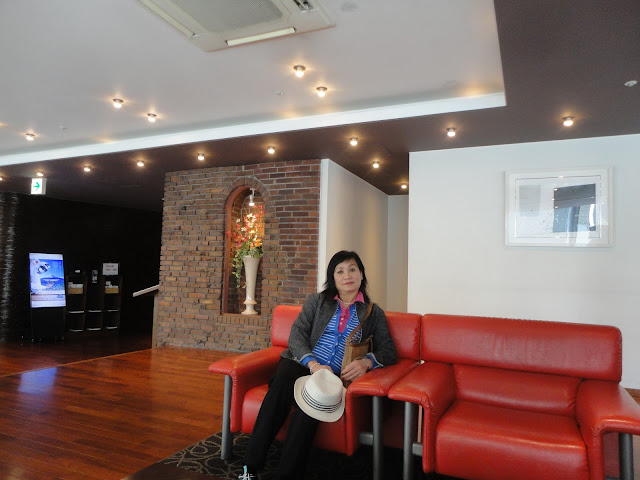



cây hồng đang có trái trồng dọc theo con sông trước khách sạn
có cả cây cam nữa
các chú bồ câu đứng phơi nắng


mặt nước sông phẳng lặng
garage nhiều tầng
tiệm uốn tóc này có đèn quay quay giống VN khi xưa

Yokohama
| Bài viết này cần thêm chú thích nguồn gốc để kiểm chứng thông tin. |
| Yokohama 横浜市 | |||
|---|---|---|---|
| — Thành phố quốc gia — | |||

Từ trên bên trái: Minato Mirai 21, Yokohama Chinatown, Nippon Maru, Ga Yokohama, Yokohama Marine Tower
| |||
| |||
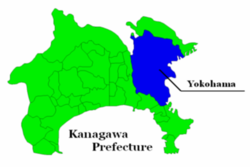 Vị trí của Yokohama ở Kanagawa | |||
| Tọa độ: 35°27′B 139°38′ĐTọa độ: 35°27′B 139°38′Đ | |||
| Quốc gia | Nhật Bản | ||
| Vùng | Kantō | ||
| Tỉnh | Kanagawa | ||
| Thủ phủ | Naka-ku | ||
| Chính quyền | |||
| • Thị trưởng | Hayashi Fumiko | ||
| Diện tích | |||
| • Tổng cộng | 437,35 km2 (16,886 mi2) | ||
| Dân số (August 2007) | |||
| • Tổng cộng | 3.625.000 | ||
| • Mật độ | 8.288/km2 (21,470/mi2) | ||
| Múi giờ | Giờ chuẩn Nhật Bản(UTC+9) | ||
| 14100-3, 221-0001–221-0866 | |||
| Mã điện thoại | 45 | ||
| Thành phố kết nghĩa | San Diego, Lyon, Mumbai, Odessa, Vancouver, Manila, Constanța, Thượng Hải, Chimbote, Frankfurt am Main, Bremen | ||
| - Cây | Camellia, Chinquapin, Sangoju Sasanqua, Ginkgo, Zelkova | ||
| - Hoa | Rose | ||
| Điện thoại | 045-671-2121 | ||
| Địa chỉ | 1-1 Minato-chō, Naka-ku, Yokohama-shi, Kanagawa-ken 231-0017 | ||
| Trang web | City of Yokohama | ||
Lịch sử[sửa | sửa mã nguồn]
- Aoba-ku (青葉区)
- Asahi-ku (旭区)
- Hodogaya-ku (保土ヶ谷区)
- Isogo-ku (磯子区)
- Izumi-ku (泉区)
- Kanagawa-ku (神奈川区)
- Kanazawa-ku (金沢区)
- Kōhoku-ku (港北区)
- Kōnan-ku (港南区)
- Midori-ku (緑区)
- Minami-ku (南区)
- Naka-ku (中区)
- Nishi-ku (西区)
- Sakae-ku (栄区)
- Seya-ku (瀬谷区)
- Totsuka-ku (戸塚区)
- Tsurumi-ku (鶴見区)
- Tsuzuki-ku (都築区)
Tham khảo[sửa | sửa mã nguồn]
- ^ Der Große Brockhaus. 16. edition. Vol. 6. F. A. Brockhaus, Wiesbaden 1955, p. 82
- ^ “Official Yokohama city website it is fresh”. City.yokohama.jp. Truy cập ngày 5 tháng 5 năm 2010.
- ^ Arita, Erika, "Happy Birthday Yokohama!", The Japan Times, ngày 24 tháng 5 năm 2009, p. 7.
| |||
| ||
| ||
***************************************
Yokohama
| Yokohama 横浜市 | |||
|---|---|---|---|
| Designated city | |||
| City of Yokohama[1] | |||

From top left: Minato Mirai 21, Yokohama Chinatown, Nippon Maru, Yokohama Station, Yokohama Marine Tower
| |||
| |||
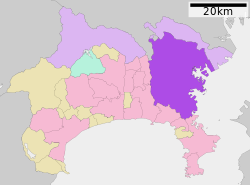 Map of Kanagawa Prefecture with Yokohama highlighted in purple | |||
| Coordinates: 35°26′39″N 139°38′17″ECoordinates: 35°26′39″N 139°38′17″E | |||
| Country | Japan | ||
| Region | Kantō | ||
| Prefecture | Kanagawa Prefecture | ||
| Government | |||
| • Mayor | Fumiko Hayashi | ||
| Area | |||
| • Total | 437.38 km2 (168.87 sq mi) | ||
| Population (October 1, 2016) | |||
| • Total | 3,732,616 | ||
| • Density | 8,534.03/km2 (22,103.0/sq mi) | ||
| Time zone | Japan Standard Time(UTC+9) | ||
| – Tree | Camellia, Chinquapin, Sangoju Sasanqua, Ginkgo, Zelkova | ||
| – Flower | Rose | ||
| Phone number | 045-671-2121 | ||
| Address | 1-1 Minato-chō, Naka-ku, Yokohama-shi, Kanagawa-ken 231-0017 | ||
| Website | www | ||
| Yokohama | |||
| Japanese name | |||
|---|---|---|---|
| Kyūjitai | 橫濱 | ||
| Shinjitai | 横浜 | ||
| |||
Contents
[hide]History[edit]
Opening of the Treaty Port (1859–1868)[edit]
Meiji and Taisho Periods (1868–1923)[edit]
Great Kanto earthquake and the Second World War (1923–1945)[edit]
Post-World War II growth[edit]
Historical population[edit]
| Year of census | Population | Rank among cities in Japan |
|---|---|---|
| 1920 | 422,942 | 6th, behind Kobe, Kyoto, Nagoya, Osaka, and Tokyo |
| 1925 | 405,888 | 6th |
| 1930 | 620,306 | 6th |
| 1935 | 704,290 | 6th |
| 1940 | 968,091 | 5th, surpassing Kobe |
| 1945 | 814,379 | 4th, the city government of Tokyo having been disbanded in 1943 |
| 1950 | 951,189 | 4th |
| 1955 | 1,143,687 | 4th |
| 1960 | 1,375,710 | 3rd, surpassing Kyoto |
| 1965 | 1,788,915 | 3rd |
| 1970 | 2,238,264 | 2nd, surpassing Nagoya |
| 1975 | 2,621,771 | 2nd |
| 1980 | 2,773,674 | 1st, surpassing Osaka[11] |
| 1985 | 2,992,926 | 1st |
| 1990 | 3,220,331 | 1st |
| 1995 | 3,307,136 | 1st |
| 2000 | 3,426,651 | 1st |
| 2005 | 3,579,133 | 1st |
| 2010 | 3,670,669 | 1st |
| 2015 | 3,710,824 | 1st |
Climate[edit]
| [hide]Climate data for Yokohama, Kanagawa (1981–2010 except for records) | |||||||||||||
|---|---|---|---|---|---|---|---|---|---|---|---|---|---|
| Month | Jan | Feb | Mar | Apr | May | Jun | Jul | Aug | Sep | Oct | Nov | Dec | Year |
| Record high °C (°F) | 20.8 (69.4) | 24.8 (76.6) | 24.5 (76.1) | 28.7 (83.7) | 31.1 (88) | 35.5 (95.9) | 36.9 (98.4) | 37.4 (99.3) | 36.2 (97.2) | 30.9 (87.6) | 26.2 (79.2) | 23.5 (74.3) | 37.4 (99.3) |
| Average high °C (°F) | 9.9 (49.8) | 10.3 (50.5) | 13.2 (55.8) | 18.5 (65.3) | 22.4 (72.3) | 24.9 (76.8) | 28.7 (83.7) | 30.6 (87.1) | 26.7 (80.1) | 21.5 (70.7) | 16.7 (62.1) | 12.4 (54.3) | 19.7 (67.5) |
| Daily mean °C (°F) | 5.9 (42.6) | 6.2 (43.2) | 9.1 (48.4) | 14.2 (57.6) | 18.3 (64.9) | 21.3 (70.3) | 25.0 (77) | 26.7 (80.1) | 23.3 (73.9) | 18.0 (64.4) | 13.0 (55.4) | 8.5 (47.3) | 15.8 (60.4) |
| Average low °C (°F) | 2.3 (36.1) | 2.6 (36.7) | 5.3 (41.5) | 10.4 (50.7) | 15.0 (59) | 18.6 (65.5) | 22.4 (72.3) | 24.0 (75.2) | 20.6 (69.1) | 15.0 (59) | 9.6 (49.3) | 4.9 (40.8) | 12.5 (54.5) |
| Record low °C (°F) | −8.2 (17.2) | −6.8 (19.8) | −4.6 (23.7) | −0.5 (31.1) | 3.6 (38.5) | 9.2 (48.6) | 13.3 (55.9) | 15.5 (59.9) | 11.2 (52.2) | 2.2 (36) | −2.4 (27.7) | −5.6 (21.9) | −8.2 (17.2) |
| Average precipitation mm (inches) | 58.9 (2.319) | 67.5 (2.657) | 140.7 (5.539) | 144.1 (5.673) | 152.2 (5.992) | 190.4 (7.496) | 168.9 (6.65) | 165.0 (6.496) | 233.8 (9.205) | 205.5 (8.091) | 107.0 (4.213) | 54.8 (2.157) | 1,688.8 (66.488) |
| Average snowfall cm (inches) | 5 (2) | 6 (2.4) | 1 (0.4) | 0 (0) | 0 (0) | 0 (0) | 0 (0) | 0 (0) | 0 (0) | 0 (0) | 0 (0) | 0 (0) | 12 (4.8) |
| Average precipitation days (≥ 0.5 mm) | 6.0 | 6.7 | 11.8 | 11.1 | 11.5 | 13.6 | 11.7 | 8.7 | 12.7 | 11.5 | 8.3 | 5.5 | 119.1 |
| Average snowy days | 1.6 | 2.3 | 0.7 | 0.0 | 0.0 | 0.0 | 0.0 | 0.0 | 0.0 | 0.0 | 0.0 | 0.3 | 4.9 |
| Average relative humidity (%) | 53 | 54 | 60 | 65 | 70 | 78 | 78 | 76 | 76 | 71 | 64 | 56 | 67 |
| Mean monthly sunshine hours | 186.4 | 164.0 | 159.5 | 175.2 | 177.1 | 131.7 | 162.9 | 206.3 | 130.7 | 141.0 | 149.3 | 180.4 | 1,964.4 |
| Source #1: [14] | |||||||||||||
| Source #2: [15] (records) | |||||||||||||
Politics and government[edit]
Wards[edit]
|
|
Economy[edit]
Maritime Port[edit]
Transport[edit]
Railway stations[edit]
- ■ East Japan Railway Company
- ■ Tōkaidō Main Line
- ■ Yokosuka Line
- – Yokohama – Hodogaya – Higashi-Totsuka – Totsuka –
- ■ Keihin-Tōhoku Line
- – Tsurumi – Shin-Koyasu – Higashi-Kanagawa – Yokohama
- ■ Negishi Line
- Yokohama – Sakuragichō – Kannai – Ishikawachō – Yamate – Negishi – Isogo – Shin-Sugita – Yōkōdai – Kōnandai – Hongōdai –
- ■ Yokohama Line
- Higashi-Kanagawa – Ōguchi – Kikuna – Shin-Yokohama – Kozukue – Kamoi – Nakayama – Tōkaichiba – Nagatsuta –
- ■ Nambu Line
- – Yakō –
- ■ Tsurumi Line
- Main Line : Tsurumi – Kokudō – Tsurumi-Ono – Bentembashi – Asano – Anzen –
- Umi-Shibaura Branch : Asano – Shin-Shibaura – Umi-Shibaura
- ■ Central Japan Railway Company
- ■ Tōkaidō Shinkansen
- – Shin-Yokohama –
- ■ Keikyu
- ■ Keikyu Main Line
- – Tsurumi-Ichiba – Keikyū Tsurumi – Kagetsuen-mae – Namamugi – Keikyū Shin-Koyasu – Koyasu – Kanagawa-Shinmachi – Naka-Kido – Kanagawa – Yokohama – Tobe – Hinodechō – Koganechō – Minami-Ōta – Idogaya – Gumyōji – Kami-Ōoka – Byōbugaura – Sugita – Keikyū Tomioka – Nōkendai – Kanazawa-Bunko – Kanazawa-Hakkei –
- ■ Keikyu Zushi Line
- Kanazawa-Hakkei – Mutsuura –
- ■ Tokyu Corporation
- ■ Tōyoko Line
- – Hiyoshi – Tsunashima – Ōkurayama – Kikuna – Myōrenji – Hakuraku – Higashi-Hakuraku – Tammachi – Yokohama
- ■ Meguro Line
- – Hiyoshi
- ■ Den-en-toshi Line
- ■ Kodomonokuni Line
- Nagatsuta – Onda – Kodomonokuni
- ■ Sagami Railway
- ■ Sagami Railway Main Line
- Yokohama – Hiranumabashi – Nishi-Yokohama – Tennōchō – Hoshikawa – Wadamachi – Kamihoshikawa – Nishiya – Tsurugamine – Futamatagawa – Kibōgaoka – Mitsukyō– Seya –
- ■ Izumino Line
- Futamatagawa – Minami-Makigahara – Ryokuentoshi – Yayoidai – Izumino – Izumi-chūō – Yumegaoka
- ■ Yokohama Minatomirai Railway
- ■ Minatomirai Line
- Yokohama – Shin-Takashima – Minato Mirai – Bashamichi – Nihon-ōdōri – Motomachi-Chūkagai
- ■ Yokohama City Transportation Bureau
- ■ Blue Line
- – Shimoiida – Tateba – Nakada – Odoriba – Totsuka – Maioka – Shimonagaya – Kaminagaya – Kōnan-Chūō – Kami-Ōoka – Gumyōji – Maita – Yoshinochō – Bandōbashi – Isezakichōjamachi – Kannai – Sakuragichō – Takashimachō – Yokohama – Mitsuzawa-shimochō – Mitsuzawa-kamichō – Katakurachō – Kishine-kōen – Shin-Yokohama – Kita Shin-Yokohama – Nippa – Nakamachidai – Center Minami – Center Kita – Nakagawa – Azamino
- ■ Green Line
- Nakayama – Kawawachō – Tsuzuki-Fureai-no-Oka – Center Minami – Center Kita – Kita-Yamata – Higashi-Yamata – Takata – Hiyoshi-Honchō – Hiyoshi
- ■ Yokohama New Transit
- ■ Kanazawa Seaside Line
- Shin-Sugita – Nambu-Shijō – Torihama – Namiki-Kita – Namiki-Chūō – Sachiura – Sangyō-Shinkō-Center – Fukuura – Shidai-Igakubu – Hakkeijima – Uminokōen-Shibaguchi– Uminokōen-Minamiguchi – Nojimakōen – Kanazawa-Hakkei
Education[edit]
Sports[edit]
- Soccer: Yokohama F. Marinos (J.League Division 1), Yokohama FC (J.League Division 2), YSCC (J.League Division 3)
- Baseball: Yokohama DeNA BayStars
- Velodrome: Kagetsu-en Velodrome
Places of interest[edit]
International relations[edit]
 Cebu City, Philippines
Cebu City, Philippines Constanța, Romania
Constanța, Romania Lyon, France[25]
Lyon, France[25] Manila, Philippines
Manila, Philippines Mumbai, India
Mumbai, India Odessa, Ukraine
Odessa, Ukraine San Diego, United States
San Diego, United States Shanghai, People's Republic of China
Shanghai, People's Republic of China Frankfurt, Germany
Frankfurt, Germany Abidjan, Ivory Coast
Abidjan, Ivory Coast Vancouver, British Columbia, Canada[26]
Vancouver, British Columbia, Canada[26]
In fiction[edit]
This section appears to contain trivial, minor, or unrelated references to popular culture. (August 2017)
|
This section does not cite any sources. (August 2017) (Learn how and when to remove this template message)
|
- Yukio Mishima's novel The Sailor Who Fell from Grace with the Sea is set mainly in Yokohama. Mishima describes the city's port and its houses, and the Western influences that shaped them.
- From up on Poppy Hill is a 2011 Studio Ghibli animated drama film directed by Gorō Miyazaki set in the Yamate district of Yokohama. The film is based on the serialized Japanese comic book of the same name.
- The main setting of James Clavell's book Gai-Jin is in historical Yokohama.
- Some of the events of Hitoshi Ashinano's manga Yokohama Kaidashi Kikō unfold in Yokohama and its surrounding areas.
- Aya Fuse lives in the futuristic Yokohama in Scott Westerfeld's novel Extras.
- Anne McCaffrey's Dragonriders of Pern book series involves a spaceship named the Yokohama.
- One of the Pretty Cure crossover movies takes place in Yokohama. In the fourth movie of the series, Pretty Cure All Stars New Stage: Friends of the Future, the Pretty Cure appear standing on top of the Cosmo Clock 21 in Minato Mirai.
- The main setting of the Japanese visual novel series Muv-Luv, first a school and then, in an alternate history, a military base is built in Yokohama with the objective of carrying out the Alternative IV Plan meant to save humanity.
- In Command and Conquer: Red Alert 3, Yokohama is under siege by the Soviet Union and Allied Nations to stop the Empire of The Rising Sun. The player must defend Yokohama and then lead a counterattack as the Empire.
- It is the main port used in Japan in Jules Verne's Around the World in Eighty Days.
- It is one of the area where players race in the arcade Wangan Midnight Maximum Tune.
- The manga Bungo Stray Dogs is set in Yokohama.
- The Japanese mixed-media project Hamatora takes place in Yokohama.
- The final battle in Godzilla, Mothra and King Ghidorah: Giant Monsters All-Out Attack takes place in Yokohama.





























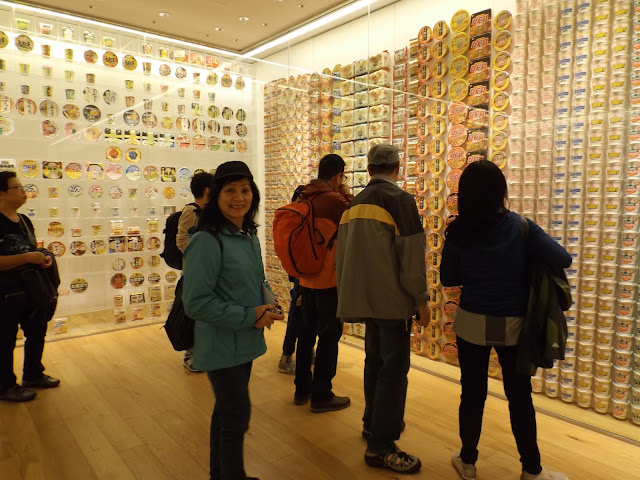





























































































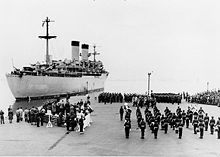

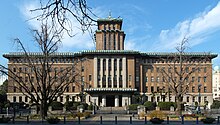

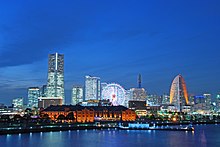
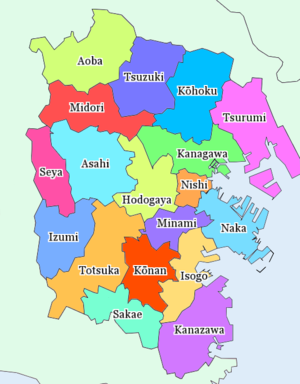



Aucun commentaire:
Enregistrer un commentaire